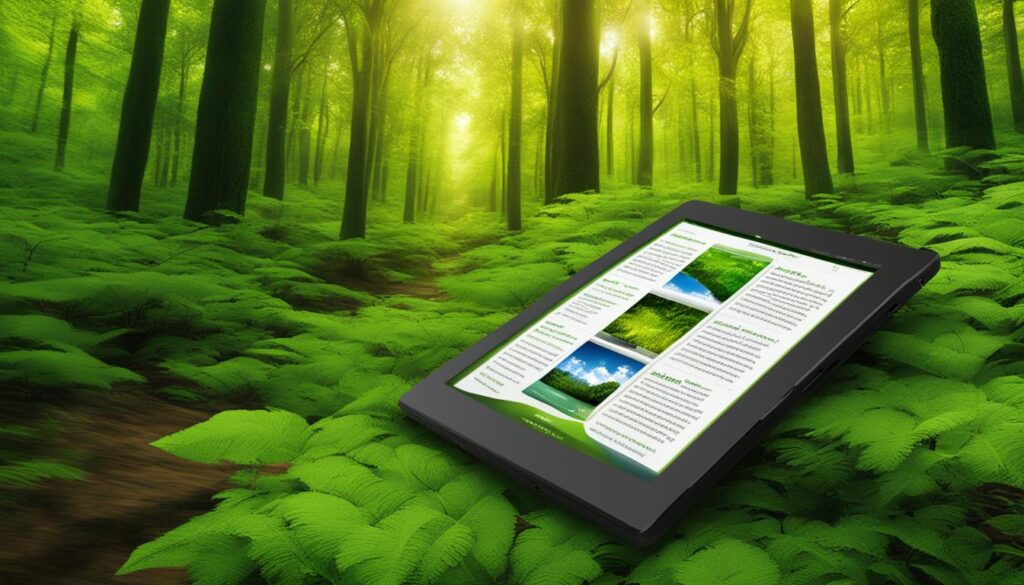Ebooks have revolutionized the way we read, providing a digital alternative to traditional printed books. In this section, we will explore the definition and introduction to ebooks, discussing their benefits and potential future advancements.
Ebooks are digital books that can be read on electronic devices such as eReaders, smartphones, and tablets. They emerged in the early 2000s and have gained popularity with the launch of devices like Amazon’s Kindle and Apple’s iPhone. Ebooks offer portability, accessibility, and convenience, allowing you to enjoy your favorite books anytime, anywhere.
As technology continues to advance, the future of reading lies in digital formats like ebooks. They have become a significant part of the book market, with sales making up 18% of all book sales in the first half of 2021. Ebooks provide a different reading experience compared to traditional printed books and have the potential to continue evolving in the future.
Key Takeaways:
- Ebooks are digital books that can be read on electronic devices
- They offer portability, accessibility, and convenience
- Ebooks have gained popularity with the rise of devices like Amazon’s Kindle and Apple’s iPhone
- They make up 18% of all book sales in the first half of 2021
- The future of reading lies in digital formats like ebooks
Advantages of Ebooks over Physical Books
Ebooks offer several advantages over physical books. One of the key benefits is their lightweight and portable nature. With ebooks, you can carry an entire library in a single device, making it convenient for travel or daily commuting. No more lugging around heavy books or worrying about limited luggage space.
Another advantage of ebooks is their accessibility and customization options. You can adjust the font size, choose from different background colors, and even use built-in dictionaries for quick word definitions. These features allow for a personalized reading experience that caters to your preferences.
Ebooks also offer convenience through searchability and bookmarking. You can easily search for specific keywords or phrases within a book, making it effortless to find relevant information. Additionally, ebooks allow you to bookmark pages and easily jump back to your favorite passages.
When it comes to sustainability, ebooks have a positive impact on the environment. By choosing ebooks over physical books, you reduce paper consumption and the carbon footprint associated with printing, shipping, and storage. It’s a small but meaningful step towards a greener future.
Comparing Ebooks and Physical Books
| Ebooks | Physical Books | |
|---|---|---|
| Portability | Lightweight and portable, carry thousands of books in one device | Can be heavy and take up space |
| Customization | Adjustable font sizes, background colors, and other settings | No customization options |
| Searchability | Easy search for specific keywords or phrases | Manual searching through pages |
| Bookmarking | Ability to bookmark pages and easily return to them | Requires physical bookmarks or manual page-folding |
| Sustainability | Reduces paper consumption, carbon footprint, and waste | Requires paper production, shipping, and storage |
Popular Ebook Formats
Ebooks are available in various formats, each with its own characteristics. Understanding the different ebook formats can help you choose the most suitable one for your reading preferences and devices. Here are some popular ebook formats explained:
EPUB (Electronic Publication)
EPUB is one of the most widely supported ebook formats. It is an open standard format that allows ebooks to adapt to different screen sizes, making them readable on various devices such as eReaders, smartphones, and tablets. EPUB files offer reflowable text, enabling readers to customize font sizes, line spacing, and margins to enhance their reading experience.
MOBI (Mobipocket)
MOBI is the format used by Amazon’s Kindle devices. It offers excellent compatibility with Kindle features and is specially designed for reading on Kindle eReaders. MOBI files support features like adjustable text size, bookmarks, annotations, and syncing across multiple devices. If you own a Kindle device, the MOBI format is the ideal choice for a seamless reading experience.
PDF (Portable Document Format)
PDF is a fixed-layout format that preserves the original formatting of a book. It is commonly used for textbooks, academic papers, and visually rich content. PDF files maintain consistent layouts across different devices, ensuring that the images, charts, and graphs in the book retain their integrity. However, the text in PDFs is not reflowable, which means it may not adapt well to different screen sizes.
AZW (Amazon Kindle Format)
AZW is Amazon’s proprietary ebook format, similar to MOBI but with additional features specific to Kindle devices. AZW files can only be read on Kindle devices or using the Kindle app. They offer features like Whispersync (syncing reading progress across devices), X-Ray (providing additional information about characters and topics), and Enhanced Typesetting (improving text clarity and reading experience). If you are an avid Kindle user, AZW is the format you’ll want to look for.
By understanding the differences between these popular ebook formats, you can make informed choices when it comes to selecting and enjoying your favorite books in digital form.
The Ebook Publishing Process
Creating an ebook involves several steps, starting with writing or preparing the content. Authors can use word processing software to create their manuscripts and format them according to the guidelines of their chosen ebook platform. Once the content is ready, authors can convert it into the desired ebook format using conversion tools or services.
They then need to add metadata, cover design, and other relevant information before uploading the ebook to online platforms like Amazon Kindle Direct Publishing or Apple Books. Authors should also consider marketing and promoting their ebooks to reach a wider audience.
Table:
| Step | Description |
|---|---|
| 1 | Write or prepare the content |
| 2 | Format the content according to ebook platform guidelines |
| 3 | Convert the content to the desired ebook format |
| 4 | Add metadata, cover design, and other relevant information |
| 5 | Upload the ebook to online platforms |
| 6 | Market and promote the ebook |
By following these steps, authors can successfully navigate the ebook publishing process and make their books available to readers worldwide.
Transforming the Ebook Experience
Ebooks have come a long way since their inception, and the future holds exciting possibilities for enhancing the reading experience. The integration of interactive elements, hypertextuality, and augmented reality has the potential to transform ebooks into immersive and engaging digital experiences.
Interactive Ebooks
Interactive ebooks offer readers a dynamic and participatory reading experience. These ebooks go beyond static text and images, incorporating multimedia elements such as videos, audio clips, and interactive games. Readers can engage with the content, explore additional materials, and delve deeper into the world of the book. By integrating interactive features, ebooks become more than just a collection of words on a page – they become interactive and captivating digital experiences.
Hypertextuality in Ebooks
Hypertextuality in ebooks opens up new possibilities for nonlinear reading experiences. With hypertext, readers can follow different narrative paths, choose different storylines, and explore various endings. This allows for a more personalized and immersive reading experience, where readers have the freedom to navigate the story in their own unique way. The nonlinear nature of hypertextuality adds depth and complexity to the reading experience, making ebooks more engaging and interactive.
Augmented Reality in Ebooks
Augmented reality (AR) has the potential to blend the digital and physical worlds, creating a truly immersive reading experience. With AR, readers can see characters and book settings come to life through their smartphone or AR-enabled devices. They can explore 3D models, interact with virtual objects, and even participate in the storyline. The integration of AR in ebooks opens up a whole new dimension of storytelling, allowing readers to step into the pages of their favorite books and experience them in unprecedented ways.
| Interactive Ebooks | Hypertextuality in Ebooks | Augmented Reality in Ebooks | |
|---|---|---|---|
| Features | Integration of multimedia elements Interactive games and activities | Nonlinear reading experiences Multiple narrative paths | Virtual characters and settings Interaction with virtual objects |
| Benefits | Enhanced engagement Deeper exploration of the content | Personalized reading experiences Freedom and flexibility in storytelling | Immersive and interactive experiences Blending of digital and physical worlds |
| Challenges | Development and implementation costs Compatibility across devices | Authoring tools and platforms Designing nonlinear narratives | Technological limitations Content creation and integration |
The Potential of VR in Books
Virtual reality (VR) technology is poised to revolutionize the reading experience, offering readers an immersive and interactive way to engage with books. With VR, you can enter a virtual world where you can explore book settings and interact with characters, creating a truly unique and unforgettable reading adventure.
Imagine stepping into the magical world of Harry Potter, where you can walk through the halls of Hogwarts, cast spells, and meet your favorite characters. Or perhaps you’d prefer to join the thrilling adventures of Sherlock Holmes, solving mysteries alongside the detective in a virtual London. VR opens up endless possibilities for enhancing the reading experience and bringing stories to life in a way that traditional reading cannot.
The immersive nature of VR allows readers to fully immerse themselves in the story, experiencing it in a whole new dimension. It adds a visual and interactive layer to the reading experience, making it more engaging and captivating. VR can transport readers to different times, places, and even fantastical realms that were once only limited to the imagination.
Table: Comparison of Reading Experiences: Traditional vs. VR
| Traditional Reading | VR Reading |
|---|---|
| Passive reading experience | Interactive and immersive reading experience |
| Limited visual imagery | Detailed, lifelike visual representations |
| Reader’s imagination fills in the gaps | Virtual world brings the story to life |
| No direct interaction with characters | Opportunity to interact with characters and environments |
| Reading limited to text and illustrations | Multimedia elements enhance the storytelling |
VR offers a new frontier for the storytelling experience, combining the power of literature with the captivating immersion of virtual reality. It has the potential to revolutionize not only how we read books but also how we engage with stories and narratives as a whole. The possibilities for VR in books are truly limitless, and with advancements in technology, we can expect even more incredible experiences in the future.
The Changing Landscape of Reading
Digital technologies have revolutionized the way we read, transforming the landscape of reading in the digital age. With the advent of ebooks and the widespread use of mobile devices, reading has become more convenient and accessible than ever before. The evolution of reading habits can be attributed to various factors, including the portability and flexibility offered by digital technologies.
Advancements in digital technologies have reshaped the reading experience, opening up new possibilities for interactive and immersive storytelling. Hypertextuality in ebooks, for example, allows readers to explore nonlinear narratives and choose their own reading paths. This interactive element adds a new dimension to storytelling, blurring the lines between traditional books and digital content. With the integration of multimedia elements, enhanced ebooks provide a more engaging and dynamic reading experience.
“Digital technologies have had a profound impact on the way we read, from the accessibility and convenience of ebooks to the interactive and immersive experiences provided by hypertextuality.”
Furthermore, the digital age has led to changes in reading preferences, with a shift towards digital formats. Digital technologies have made it easier for readers to access a wide range of books and discover new authors. Online platforms and ebook retailers have democratized the publishing industry, allowing independent authors to self-publish their works and reach a global audience. This has created opportunities for diverse voices and niche genres to thrive in the digital landscape.
The future of reading is intertwined with the continuous advancements in digital technologies. As virtual reality, artificial intelligence, and other emerging technologies continue to evolve, we can expect further transformations in the way we consume and engage with books. The digital revolution has opened up a world of possibilities, expanding access to literature and redefining the reading experience for generations to come.
Independent Publishing in the Ebook Market
The ebook market has seen a significant rise in self-published ebooks, with independent authors finding success in the digital publishing landscape. Platforms like Amazon Kindle Direct Publishing have made it easier for authors to publish and distribute their ebooks without the need for a traditional publisher. This shift has given authors more control over their work, from content to pricing and marketing strategies.
One of the key advantages of self-publishing is the ability to set lower prices compared to traditionally published titles. Self-published ebooks often attract price-conscious readers, providing them with affordable options while still enjoying quality content. Independent authors can also experiment with different genres and niche markets, catering to specific interests and building a dedicated readership.
Moreover, self-publishing allows authors to retain full creative control over their ebooks. They can decide on cover designs, formatting, and even collaborate with other professionals like editors and designers to ensure the best possible product. This level of autonomy empowers authors to bring their vision to life and connect directly with readers.
Advantages of Self-Publishing in the Ebook Market
- Lower prices compared to traditionally published titles, attracting price-conscious readers.
- Greater control over content, pricing, and marketing strategies.
- Ability to experiment with different genres and niche markets.
- Retain full creative control over cover design, formatting, and collaborations.
While traditional publishers may have seen a decline in ebook sales, self-published authors continue to thrive, meeting the demand for diverse and unique content. With the increasing popularity of ebooks and the wide reach of online platforms, independent publishing offers a viable path for authors to share their stories and connect with readers in the ever-evolving ebook market.
The Changing Landscape of Ebook Retailers
The ebook market has witnessed significant changes in the landscape of ebook retailers over time. While Amazon’s Kindle platform remains one of the leading ebook retailers, other platforms like Apple Books, Barnes & Noble’s NOOK, and Kobo have also established a significant presence in the market. With the availability of ebooks on various devices such as smartphones, tablets, eReaders, and computers, readers now have more options for purchasing and reading their favorite books.
To illustrate the presence of these ebook platforms, let’s take a look at the top ebook retailers in the market:
| Ebook Retailer | Key Features |
|---|---|
| Amazon Kindle | – Wide range of ebooks – Dedicated Kindle devices – Kindle Unlimited subscription |
| Apple Books | – Seamless integration with Apple devices – Enhanced reading features – Apple Bookstore ecosystem |
| Barnes & Noble NOOK | – NOOK eReader devices – Vast ebook selection – Personalized reading recommendations |
| Kobo | – Global ebook platform – Kobo eReader devices – Access to a range of third-party ebook retailers |
The competition among these ebook retailers has led to innovations in terms of pricing, user experience, and features. This has benefitted readers, who now have access to a wide variety of ebooks across multiple platforms. Additionally, ebook retailers have also introduced subscription services like Kindle Unlimited and Kobo Plus, offering readers a cost-effective way to explore and consume a vast library of ebooks.
As the ebook market continues to evolve, it is likely that we will see further changes in the landscape of ebook retailers. New players may enter the market, offering unique features and services to cater to readers’ evolving needs and preferences. These changes will provide readers with more choices and enhance the overall digital reading experience.
In a recent study conducted by the American Library Association, 72% of public libraries reported offering ebooks to their patrons, reflecting the growing importance of digital reading materials in the library system. The demand for ebooks in libraries continues to grow, with libraries investing in expanding their digital collections and improving the user experience of borrowing ebooks.
Advancements in Ereader Technology
Ereaders have come a long way since their initial introduction, and the future holds even more exciting possibilities. With each new generation of devices, advancements in ereader technology continue to enhance the reading experience. From improved displays to innovative features, these devices are evolving to meet the changing needs of avid readers.
One of the key advancements in ereader technology is the introduction of adjustable front lighting. This feature allows readers to adjust the brightness of the screen according to their preferences, making it easier to read in various lighting conditions. Whether you’re reading in bright sunlight or in a dimly lit room, you can optimize the reading experience for maximum comfort.
Another notable development is the inclusion of high-resolution displays in the latest ereader models. These displays offer sharper text and images, providing a more visually pleasing reading experience. With higher pixel density, the text appears crisper, making it easier on the eyes during long reading sessions.
“Ereaders with adjustable front lighting and high-resolution displays offer a more comfortable and visually appealing reading experience.” – Ebook Enthusiast
Waterproofing is another feature that has gained popularity among ereader manufacturers. Waterproof ereaders allow readers to enjoy their favorite books by the beach, at the pool, or even in the bathtub without worrying about water damage. This added durability provides peace of mind and allows for more flexibility in where and when you can read.
| Ereader Model | Adjustable Front Lighting | High-Resolution Display | Waterproof |
|---|---|---|---|
| Kindle Paperwhite | Yes | 300 PPI | Yes |
| Kobo Libra H2O | Yes | 300 PPI | Yes |
| Nook GlowLight Plus | Yes | 300 PPI | Yes |
As the demand for digital reading continues to grow, ereader manufacturers are constantly innovating and introducing new features to enhance the reading experience. From adjustable front lighting and high-resolution displays to waterproofing, these advancements allow you to enjoy your favorite books with greater convenience and comfort. The future of ereader technology holds even more exciting possibilities, promising an immersive and enjoyable reading experience for all book lovers.
Ebooks eliminate the need for paper, reducing the demand for raw materials and decreasing the amount of waste generated from unsold books and packaging materials. Unlike physical books, ebooks are delivered electronically, eliminating the energy and resources required for transportation and distribution. This digital nature of ebooks makes them a more sustainable choice for readers who are conscious of their environmental impact.
Additionally, the digital format of ebooks allows for easy updates and revisions, eliminating the need for new print runs and reducing waste. With the ability to store thousands of books on a single device, ebooks also save physical storage space, further reducing the environmental footprint associated with bookshelves and libraries.
| Environmental Impact of Ebooks: | Environmental Impact of Printed Books: |
|---|---|
| – Reduced deforestation | – Deforestation for paper production |
| – Lower energy consumption | – Energy used in book production and transportation |
| – Reduced greenhouse gas emissions | – Emissions from book production and transportation |
| – Decreased waste generation | – Waste from unsold books and packaging materials |
| – Efficient use of resources | – Resource-intensive paper production |
In conclusion, ebooks offer a sustainable and environmentally friendly reading option. By choosing ebooks over traditional printed books, you can reduce deforestation, energy consumption, greenhouse gas emissions, and waste generation. Embracing eco-friendly reading habits and opting for ebooks contributes to the conservation of our planet’s resources and helps create a greener future for generations to come.
Opportunities for Open Publishing
Open publishing platforms have emerged as a way to encourage collaboration, accessibility, and innovation in the publishing industry. These platforms provide opportunities for authors and publishers to create enhanced editions of books, particularly in the scholarly monograph domain. Through open publishing, traditional barriers to entry are reduced, allowing for a more inclusive and diverse range of voices to be heard. Open publishing platforms enable the integration of multimedia, social reading features, and flexible online reading experiences, providing readers with a more interactive and engaging reading experience.
One example of an open publishing platform is Manifold, which allows authors and publishers to create enhanced editions of scholarly works. Manifold offers features like annotation tools, interactive maps, and multimedia integration, enriching the reading experience and facilitating deeper engagement with the content. PubPub is another open publishing platform that enables collaborative book production, offering version control, commenting features, and interactive elements. These platforms empower authors to experiment with different formats and engage readers in new and exciting ways.
Open Source Publishing
Open source publishing is another aspect of open publishing that promotes transparency and accessibility. Open source software provides authors and publishers with the ability to customize and modify publishing tools and workflows to suit their specific needs. This fosters a sense of community and collaboration, as users can contribute to the development and improvement of these tools. Open source publishing ensures that the publishing process remains accessible, democratic, and adaptable to changing technological advancements.
Open publishing platforms and open source publishing provide opportunities to challenge traditional publishing models and explore innovative approaches to content creation and dissemination. By embracing these platforms and practices, authors and publishers can create enhanced editions of books that push the boundaries of traditional reading experiences.
| Open Publishing Platforms | Description |
|---|---|
| Manifold | An open publishing platform that allows authors and publishers to create enhanced editions of scholarly works with features like annotation tools and multimedia integration. |
| PubPub | A collaborative open publishing platform that enables version control, commenting features, and interactive elements for a more engaging reading experience. |
| Fulcrum | An open publishing platform that specializes in digital humanities, offering tools for multimedia integration and interactive content creation. |
Hypertextuality in Ebooks: Exploring Interactive Storytelling and Nonlinear Reading Experiences
In today’s digital age, ebooks have opened up new possibilities for storytelling, offering readers a more interactive and immersive reading experience. One significant development in ebooks is the concept of hypertextuality, which allows for nonlinear reading experiences. Unlike traditional linear narratives, hypertextual ebooks enable readers to navigate through various pathways and explore multiple storylines within a single text.
Through hypertextuality, readers can delve into different plotlines, characters, and settings, creating a personalized reading journey. This interactive approach to storytelling offers a sense of agency, allowing readers to make choices and explore various narrative directions. With hypertextuality, ebooks become dynamic and adaptable, catering to the individual preferences and interests of readers.
Imagine reading a mystery novel where you have the freedom to choose which character to follow, making decisions that affect the outcome of the story. Or picture exploring a fantasy world where you can delve deeper into the history and mythology of the universe by following hyperlinks within the text. Hypertextuality in ebooks opens up a whole new realm of possibilities for authors and readers alike.
“Hypertextual ebooks offer readers a unique reading experience, blurring the lines between literature, gaming, and interactive media. With the ability to navigate through different pathways and explore multiple storylines, readers become active participants in the storytelling process.” – Ebooks Magazine
Table: Examples of Hypertextuality in Ebooks
| Ebook Title | Description |
|---|---|
| The Dreaming Tree | A fantasy novel where readers can choose to follow different characters and unlock hidden aspects of the story through hypertextual links. |
| Dark Secrets | A mystery thriller where readers can make choices for the protagonist, uncovering clues and solving the case in their own unique way. |
| Through the Looking Glass | A literary classic reimagined as a hypertextual ebook, allowing readers to explore additional context, annotations, and interpretations of the text. |
As technology continues to advance, we can expect even more innovative and engaging hypertextual ebooks in the future. The convergence of literature, interactivity, and digital media opens up exciting possibilities for the evolution of storytelling. By embracing hypertextuality in ebooks, authors can create dynamic narratives that captivate readers and offer them unique reading experiences.
The Future of Reading in the Digital Age
The advent of ebooks has revolutionized the way we read and opened up a world of possibilities for the future of reading. As technology continues to advance, ebooks are expected to play a significant role in transforming the literary landscape. With their portability, accessibility, and enhanced reading experiences, ebooks offer numerous advantages over physical books.
As we embrace the digital revolution, the future of reading looks promising. Enhanced ebooks, with interactive elements and augmented reality, provide a more immersive and engaging reading experience. Virtual reality technologies have the potential to bring books to life in ways we never imagined, allowing readers to explore and interact with book settings and characters.
The rise of self-publishing has given independent authors a platform to share their work, while libraries are embracing ebooks for digital lending, making reading more accessible to a wider audience. Meanwhile, advancements in ereader technology continue to enhance the reading experience, with features like adjustable front lighting and high-resolution displays.
By embracing digital reading and the convenience and flexibility it offers, we can contribute to sustainability efforts by reducing paper consumption and eliminating waste. The future of reading is undoubtedly digital, and ebooks are at the forefront of this evolving landscape, shaping the way we consume and interact with literature.
FAQ
What is an ebook?
An ebook is a digital book that can be read on electronic devices such as eReaders, smartphones, and tablets.
What are the advantages of ebooks over physical books?
Ebooks are lightweight and portable, offer adjustable font sizes and background colors, provide convenience through features like searchability and bookmarking, and contribute to a more sustainable reading experience.
What are some popular ebook formats?
Some popular ebook formats include EPUB, MOBI, PDF, and AZW.
How do you create an ebook?
Creating an ebook involves writing or preparing the content, converting it into the desired ebook format, adding metadata and cover design, and uploading it to online platforms like Amazon Kindle Direct Publishing or Apple Books.
What is the future of enhanced ebooks?
Enhanced ebooks go beyond the traditional reading experience by incorporating interactive elements, hypertextuality, and augmented reality. They have the potential to provide more immersive and engaging reading experiences.
How does virtual reality impact the reading experience?
Virtual reality allows readers to enter a virtual world where they can explore and interact with book settings and characters, providing an immersive reading experience.
How have digital technologies impacted the reading landscape?
Digital technologies have made reading more convenient and accessible, leading to changes in reading habits and preferences. The integration of technologies like augmented reality and virtual reality has expanded the possibilities for immersive reading experiences.
What are the advantages of self-publishing in the ebook market?
Self-publishing allows independent authors to have more control over their ebook’s content, pricing, and marketing strategies. It also offers opportunities for lower prices and thriving in the digital publishing landscape.
How has the landscape of ebook retailers changed?
Ebook retail platforms like Amazon Kindle, Apple Books, Barnes & Noble’s NOOK, and Kobo have emerged as significant players in the ebook market, leading to innovations, better pricing, and improved user experiences for readers.
How have ebooks impacted the library system?
Ebooks have expanded library services by allowing digital lending through platforms like Overdrive, increasing accessibility to a wide range of reading materials.
What advancements have been made in ereader technology?
Ereader devices offered by companies like Amazon, Barnes & Noble, and Kobo continue to improve with features like adjustable front lighting, high-resolution displays, and waterproofing.
What is the environmental impact of ebooks?
Ebooks have a positive impact on the environment by reducing the need for paper and physical production, distribution, and storage.
What are open publishing platforms?
Open publishing platforms encourage collaboration, accessibility, and innovation in publishing, allowing authors and publishers to create enhanced editions of books with multimedia and interactive features.
What is hypertextuality in ebooks?
Hypertextuality allows for nonlinear reading experiences, where readers can explore different pathways and possibilities within a text.
What does the future hold for reading in the digital age?
The future of reading is digital, with ebooks at the forefront of transforming the literary world and offering convenience, flexibility, and enhanced reading experiences.







